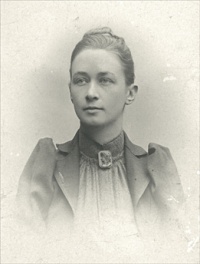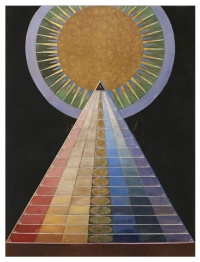Hilma af Klint: Difference between revisions
No edit summary |
No edit summary |
||
| Line 5: | Line 5: | ||
[[File:Hilma af Klint.jpg|right|200px|thumb|Hilma af Klint]] | [[File:Hilma af Klint.jpg|right|200px|thumb|Hilma af Klint]] | ||
[[File:Klint - Light.jpg|right|200px|thumb|''Alterpiece'', 1915. Tempera on paper.]] | [[File:Klint - Light.jpg|right|200px|thumb|''Alterpiece'', 1915. Tempera on paper.]] | ||
'''Hilma af Klint''', (October 26, 1862 – October 21, 1944) was a Swedish artist and mystic whose paintings were amongst the first abstract art. A considerable body of her abstract work predates the first purely abstract compositions by [[Wassily Kandinsky|Kandinsky]]. | '''Hilma af Klint''', ([[October 26]], 1862 – [[October 21]], 1944) was a Swedish artist and [[Mysticism|mystic]] whose paintings were amongst the first abstract art. A considerable body of her abstract work predates the first purely abstract compositions by [[Wassily Kandinsky|Kandinsky]]. | ||
Her art had a Theosophical influence. By the late 1870s she began to participate in séances, and soon developed an interest in Theosophy and the occult, as would be the case of [[Piet Mondrian|Mondrian]] and Kandinsky some years later. | Her art had a [[Theosophy|Theosophical]] influence. By the late 1870s she began to participate in séances, and soon developed an interest in Theosophy and the occult, as would be the case of [[Piet Mondrian|Mondrian]] and Kandinsky some years later. | ||
<blockquote> | |||
Hilma af Klint was only introduced to a wider audience at the 1986 ''The Spiritual in Art'' exhibition. She was trained and initially worked as a conventional artist, but in the 1890s af Klint participated in [[Spiritualism|Spiritualist]] sessions and started to draw under the influence of spirits. She owned a Swedish edition of [[Helena Petrovna Blavatsky|Blavatsky's]] [[The Secret Doctrine (book)|''Secret Doctrine'']] and Theosophical ideas quickly gained ground within these sessions. Between 1905 and 1907 af Klint realized a first series of esoteric paintings, called "drawings for the temple," created under the guidance of a spirit called Amaliel. After meeting [Rudolf] [[Rudolf Steiner|Steiner]] in 1908 she ceased painting to study [[Anthroposophy]], eventually returning to and finishing the temple-series between 1912 and 1915. The series explores the major Theosophical theme of the cosmic dynamics between male and female and their eventual unity, also central to [[Piet Mondrian|Mondrian's]] work. Her works are, notably, abstract. Similarly to the other artists associated with Theosophy, form (mostly abstract) was of prime importance to af Klint, as well as a particular symbolism of color; for her blue, the lily, and the eye represented femininity; yellow, the rose, and the hook masculinity (Lampe 2008: 130). She never exhibited during her life and left an oeuvre of over 1,000 paintings (Rousseau 2008).<ref>Tessel M. Bauduin, "Abstract Art as 'By-Product of Astral Manifestation': The Influence of Theosophy on Modern Art in Europe" ''Handbook of the Theosophical Current'' (Leiden: Brill, 2013),440-441.</ref> | |||
</blockquote> | |||
== Additional resources == | == Additional resources == | ||
| Line 21: | Line 25: | ||
[[Category:Artists|Hilma af Klint]] | [[Category:Artists|Hilma af Klint]] | ||
[[Category:Mystics|Hilma af Klint]] | [[Category:Mystics|Hilma af Klint]] | ||
[[Category:Spiritualists|Hilma af Klint]] | |||
[[Category:Writers|Hilma af Klint]] | [[Category:Writers|Hilma af Klint]] | ||
[[Category:Nationality Swedish|Hilma af Klint]] | [[Category:Nationality Swedish|Hilma af Klint]] | ||
[[Category:Famous people|Hilma af Klint]] | [[Category:Famous people|Hilma af Klint]] | ||
Revision as of 14:53, 10 January 2017

Hilma af Klint, (October 26, 1862 – October 21, 1944) was a Swedish artist and mystic whose paintings were amongst the first abstract art. A considerable body of her abstract work predates the first purely abstract compositions by Kandinsky.
Her art had a Theosophical influence. By the late 1870s she began to participate in séances, and soon developed an interest in Theosophy and the occult, as would be the case of Mondrian and Kandinsky some years later.
Hilma af Klint was only introduced to a wider audience at the 1986 The Spiritual in Art exhibition. She was trained and initially worked as a conventional artist, but in the 1890s af Klint participated in Spiritualist sessions and started to draw under the influence of spirits. She owned a Swedish edition of Blavatsky's Secret Doctrine and Theosophical ideas quickly gained ground within these sessions. Between 1905 and 1907 af Klint realized a first series of esoteric paintings, called "drawings for the temple," created under the guidance of a spirit called Amaliel. After meeting [Rudolf] Steiner in 1908 she ceased painting to study Anthroposophy, eventually returning to and finishing the temple-series between 1912 and 1915. The series explores the major Theosophical theme of the cosmic dynamics between male and female and their eventual unity, also central to Mondrian's work. Her works are, notably, abstract. Similarly to the other artists associated with Theosophy, form (mostly abstract) was of prime importance to af Klint, as well as a particular symbolism of color; for her blue, the lily, and the eye represented femininity; yellow, the rose, and the hook masculinity (Lampe 2008: 130). She never exhibited during her life and left an oeuvre of over 1,000 paintings (Rousseau 2008).[1]
Additional resources
- Seven articles about Hilma af Klint are listed in the Union Index of Theosophical Periodicals.
- "Art and About: Hilma af Klint".
- Bax, Marty. "Hilma and the Enigmatic Mathilde N." Bax Art Concepts & Services blog. October 4, 2013. Available at Baxpress.blogspot. Viewed October 21, 2016.
- Hilma af Klint: Painting the Unseen at the Serpentine by Louisa Buck for The Telegraph.
Notes
- ↑ Tessel M. Bauduin, "Abstract Art as 'By-Product of Astral Manifestation': The Influence of Theosophy on Modern Art in Europe" Handbook of the Theosophical Current (Leiden: Brill, 2013),440-441.

